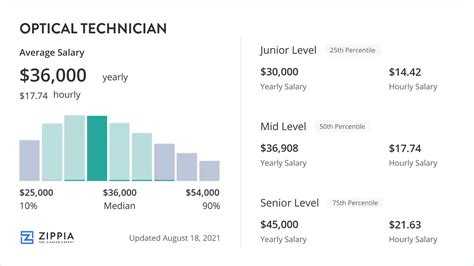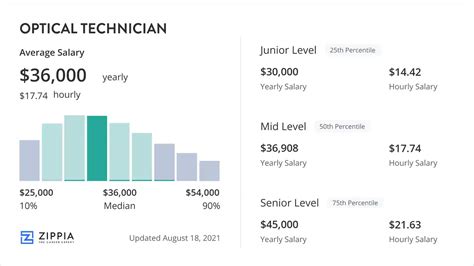Considering a career where you can combine technical skill with a passion for helping people achieve better vision? The role of an optical technician is a stable, rewarding, and accessible career path. But what can you expect to earn? An optical technician salary can vary significantly, typically ranging from around $35,000 for entry-level positions to over $60,000 for experienced or specialized professionals.
This data-driven guide will break down everything you need to know about your potential earnings as an optical technician, from average salaries to the key factors that can help you maximize your income.
What Does an Optical Technician Do?

Before diving into the numbers, it's important to understand the role. The term "optical technician" is often used to describe two closely related but distinct professions:
1. Dispensing Opticians: These are the patient-facing professionals. They help customers select the best eyeglass frames and lenses based on their prescription, lifestyle, and facial features. Their duties include taking precise measurements, adjusting and fitting glasses, repairing frames, and educating patients on lens options and proper eyewear care.
2. Ophthalmic Laboratory Technicians: These are the experts behind the scenes. They work in labs to cut, grind, edge, and finish lenses according to the specifications provided by optometrists and dispensing opticians. They use sophisticated automated equipment to create the final pair of eyeglasses.
In smaller practices, one person may perform duties from both categories. For this guide, we will analyze data for both roles to provide a complete financial picture of the profession.
Average Optical Technician Salary

So, what does the data say? The salary for an optical technician is influenced by many factors, but national averages provide a strong baseline.
According to the U.S. Bureau of Labor Statistics (BLS), the most recent data from May 2023 shows:
- The median annual wage for Dispensing Opticians was $42,670, or approximately $20.51 per hour.
- The median annual wage for Ophthalmic Laboratory Technicians was $40,270, or approximately $19.36 per hour.
Median wage means that half of the workers in the occupation earned more than that amount, and half earned less. The BLS also notes that the lowest 10% of dispensing opticians earned less than $31,550, while the highest 10% earned more than $64,480.
Reputable salary aggregators provide a similar picture:
- Salary.com reports that the median Optical Technician salary in the U.S. is $48,793, with a typical range falling between $43,156 and $55,679 (as of late 2023).
- Payscale notes an average base salary of around $19.85 per hour, with an annual salary range generally between $33,000 and $59,000.
These figures show a consistent and stable earning potential, with significant room for growth as you gain skills and experience.
Key Factors That Influence Salary

Your specific salary is not set in stone. Several key factors can significantly impact your earning potential. Understanding these variables is the first step toward building a lucrative career plan.
### Level of Education and Certification
While you can enter the field with a high school diploma and on-the-job training, investing in formal education and certification is one of the most effective ways to increase your salary.
- Formal Education: Many community colleges and vocational schools offer one-year certificate programs or a two-year associate's degree in opticianry. Graduates of these programs often command higher starting salaries because they require less initial training and possess a deeper foundational knowledge.
- Professional Certification: This is a major differentiator. The American Board of Opticianry (ABO) and National Contact Lens Examiners (NCLE) offer nationally recognized certifications. Earning your ABO certification demonstrates your competence in fitting and dispensing eyeglasses, while NCLE certification proves your expertise with contact lenses. Many employers offer higher pay or promotions to certified technicians, and some states require it for licensure.
### Years of Experience
As with most professions, experience pays. Your value to an employer grows as you become more efficient, knowledgeable, and capable of handling complex prescriptions and customer service issues.
- Entry-Level (0-2 years): Technicians just starting can expect to earn on the lower end of the spectrum, typically in the $35,000 to $42,000 range. The focus is on learning fundamental skills.
- Mid-Career (3-9 years): With several years of experience and potentially a certification, technicians can see their salaries climb into the $43,000 to $52,000 range. They may take on training new staff or managing inventory.
- Experienced/Senior (10+ years): Highly experienced technicians, especially those with advanced certifications, management responsibilities, or specialized skills, can earn $55,000 or more. Some senior opticians or lab managers can exceed $65,000.
### Geographic Location
Where you work matters. Salaries for optical technicians vary widely by state and even by metropolitan area due to differences in demand, cost of living, and state regulations.
According to the BLS, the top-paying states for Dispensing Opticians include:
1. Alaska: $62,130 (annual mean wage)
2. Massachusetts: $61,540
3. Connecticut: $58,360
4. New Jersey: $56,760
5. Rhode Island: $56,120
Conversely, states in the Southeast and rural Midwest tend to have salaries closer to or slightly below the national median. Always research the local market when considering job offers.
### Company Type
The type of establishment you work for is another major salary determinant.
- Offices of Optometrists: These private or small-group practices are the largest employers of dispensing opticians and often offer competitive, mid-range salaries.
- Large Retail Chains (e.g., LensCrafters, Visionworks, Costco): These companies often have standardized pay scales and may offer excellent benefits packages and performance bonuses. Salaries can be very competitive, especially for store managers.
- Offices of Physicians (Ophthalmologists): Working in a medical setting, often alongside ophthalmologists, can lead to higher pay, as the role may involve more complex clinical tasks.
- Optical Manufacturing Labs: Ophthalmic lab technicians typically work in these settings. While the median salary is slightly lower than for dispensing opticians, senior lab technicians and quality control managers can earn excellent wages.
### Area of Specialization
Developing a niche skill set can make you a more valuable asset and boost your income.
- Contact Lens Fitting: Technicians with NCLE certification who specialize in fitting a wide variety of contact lenses (including toric and multifocal lenses) are in high demand and can command a higher salary.
- Lab Management: An experienced ophthalmic lab technician can move into a management role, overseeing production, quality control, and staff, which comes with a significant pay increase.
- Low-Vision Aids: Specializing in helping patients with significant vision impairment find and use low-vision aids is a highly rewarding and specialized field that can lead to higher earnings.
Job Outlook

The future for optical technicians is bright. According to the BLS, employment for Dispensing Opticians is projected to grow 4% from 2022 to 2032, which is about as fast as the average for all occupations.
This steady demand is driven by several factors:
- An Aging Population: As the large baby-boomer generation ages, there will be an increased need for vision correction and eye care.
- Growing Awareness: Increased awareness of the importance of eye health and the availability of vision insurance will lead more people to seek professional eye care.
The outlook for Ophthalmic Laboratory Technicians is projected to grow by 5% over the same period, indicating stable and consistent opportunities in the manufacturing sector as well.
Conclusion

A career as an optical technician offers a stable path with solid earning potential and the immense satisfaction of helping people see the world more clearly. While the national median salary hovers in the low-to-mid $40,000s, this figure is just a starting point.
By strategically pursuing formal education, achieving professional ABO/NCLE certifications, gaining experience, and considering high-demand locations and specializations, you can significantly increase your salary. For anyone looking for a hands-on, in-demand career in healthcare, the role of an optical technician is a clear choice with a promising financial future.
